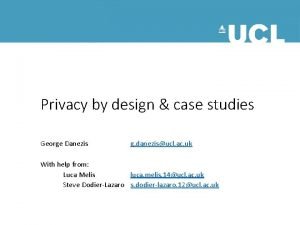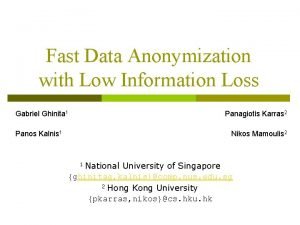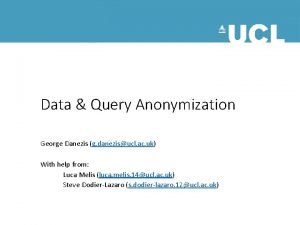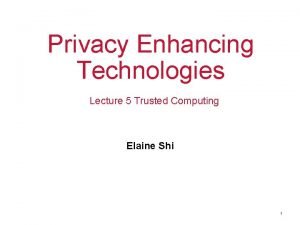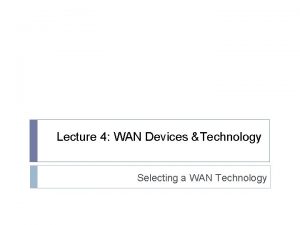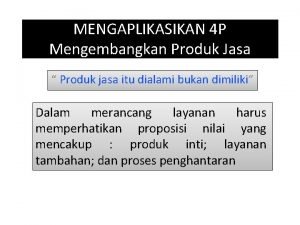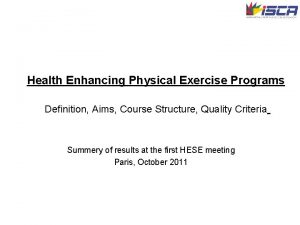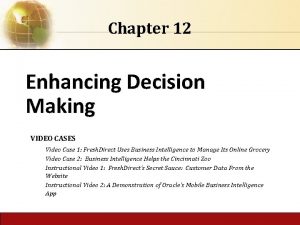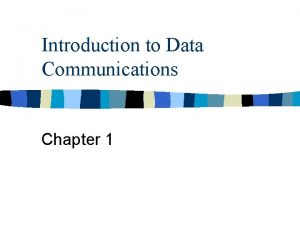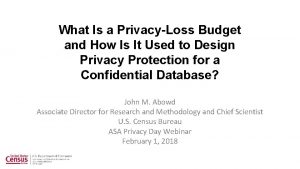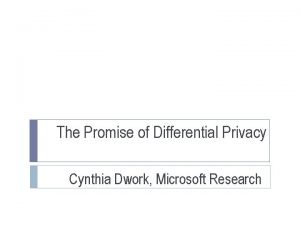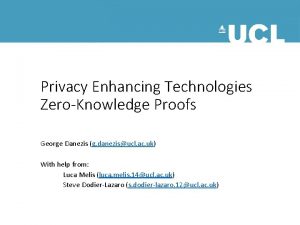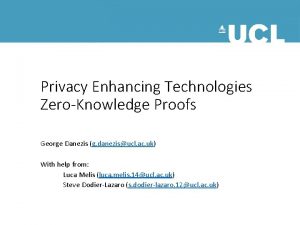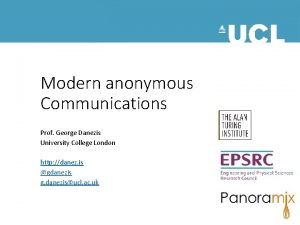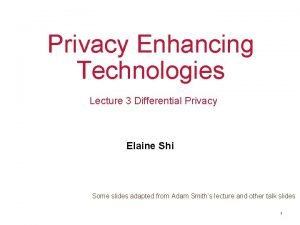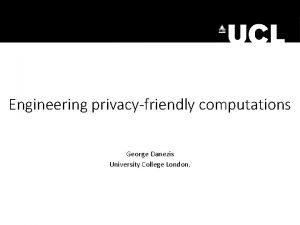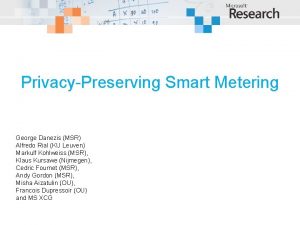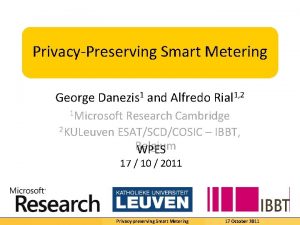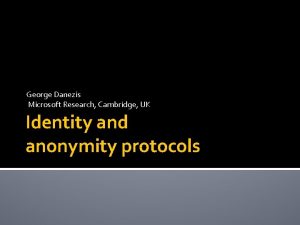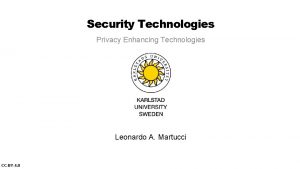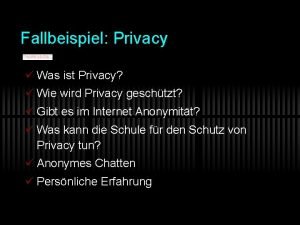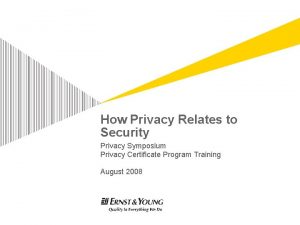Privacy Enhancing Technologies Introduction Private Communications George Danezis





































- Slides: 37

Privacy Enhancing Technologies Introduction & Private Communications. George Danezis (g. danezis@ucl. ac. uk) With help from: Luca Melis (luca. melis. 14@ucl. ac. uk) Steve Dodier-Lazaro (s. dodier-lazaro. 12@ucl. ac. uk)

Privacy as a security property • Security property: • Confidentiality – keeping a person’s secret. • Control – giving control to the individual about the use of their personal information. • Self-actualization – allowing the individual to use their information environment to further their own aims. • More to privacy: • Sociology, law, psychology, … • Eg: “The Presentation of Self in Everyday Life” (1959)

Example Privacy Harms (Solove) • A newspaper reports the name of a rape victim. • Reporters deceitfully gain entry to a person’s home and secretly photograph and record the person. • New X-ray devices can see through people’s clothing, amounting to what some call a “virtual strip-search. ” • The government uses a thermal sensor device to detect heat patterns in a person’s home. • A company markets a list of five million elderly incontinent women. • Despite promising not to sell its members’ personal information to others, a company does so anyway. Key reading: Solove, Daniel J. "A taxonomy of privacy. " University of Pennsylvania Law Review (2006): 477 -564.

Illustrated Taxonomy of Privacy Harms Image from Solove, Daniel J. "A taxonomy of privacy. " University of Pennsylvania Law Review (2006): 477 -564.

Taxonomy of privacy harms A. Information Collection 1. Surveillance 2. Interrogation B. Information Processing 1. Aggregation 2. Identification 3. Insecurity 4. Secondary Use 5. Exclusion C. Information Dissemination 1. Breach of Confidentiality 2. Disclosure 3. Exposure 4. Increased Accessibility 5. Blackmail 6. Appropriation 7. Distortion D. Invasion 1. Intrusion 2. Decisional Interference Key reading: Solove, Daniel J. "A taxonomy of privacy. " University of Pennsylvania Law Review (2006): 477 -564. Action no data required

Privacy Enhancing Technologies Soft and Hard PETs.

Aims of this course • Understand different conceptions of privacy. • Data Protection practical skills. • Understand how appropriate technologies can support privacy needs in different threat environments. • Touch on technologies, threats, and even regulatory requirements. • Practical experience with key advanced technologies (Labs): • • • End-to-End Encryption. Anonymous communications. Private computations. Zero-knowledge proofs. Selective disclosure credentials. • Experience of code quality and cryptographic implementations.

Two families of privacy technologies Soft Privacy Technologies Hard Privacy Technologies • Focus on compliance. • Focus on “internal controls”. • Assumption: a third party is entrusted with the user data. • Threat model: third party is trusted to process user data according to user wishes. • Examples technologies: • Stronger focus on data minimization. • Assumption: there exists no single third party that may be trusted with user data. • Threat model: a service is in the hands of the adversary; may be coerced; may be hacked. • Common assumption: k-out-of-n honest third parties. • May relay on service integrity if auditing is possible. • Challenge: achieve functionality without revealing data! • Access control, tunnel encryption (SSL/TLS) • “Keeping honest services safe from insiders / employees”.

Example 1: Gathering opinions (polling) Do you agree that <embarrassing statement> 1 (str. agree) – 5 (str. disagree)? Soft Privacy Approach • You trust the person collecting the answers. • Ensure secure channels so that no one else can overhear the answer. • Ensure good protection of the collected data. • Access control • Anonymization at pollster. Hard Privacy Approach • You do not trust the pollster or any other single 3 rd party to hold the answer. • You want: • Only the aggregate to be known. • If not much about your answer leaks. • Pollster wants: • You to answer only once. • Your answer to be valid (either yes or no) Note: the later labs are based on this problem.

Two sides of hard PETs: challenges Confidentiality Integrity / Abuse resistance • How can we do “stuff” (communicate, compute, store information) without revealing information to third parties? • Peer-to-peer / end-to-end: we use no third parties, but then we need to do everything amongst users. • Something good needs to happen, despite no more data than necessary being visible to services. • Hiding personal data should not allow attacks! • Example: bit-torrent, direct chat. • Dumb relays / dumb stores: we use third parties, but without allowing them to see any information. • Example: encrypted comms. / encrypted storage. • K-out-of-N: we use third parties but without allowing any coalition to learn anything. • Example: secure computation. • Example 1: anonymous cash protects against fraud / double spending. • Example 2: private billing for services, should not allow fraud. • Example 3: elections should protect voter confidentiality and disallow double voting. Multilateral policies: different parties may want confidentiality and integrity. No entity fully trusts another to guarantee those.

Example 2: confidential communications Soft Privacy Setting Hard Privacy Setting • Threat model: there exists a server that both Alice and Bob trust to respect their privacy. • Idea: encryption to server! • Solution: Alice connects to the server and uses TLS (https) to protect the confidentiality and integrity of the channel. Bob does the same. The service connects them to each other, but sees all messages in clear. Third parties do cannot see the content of messages. • Threat model: Alice and Bob do not trust any third party server to respect their privacy. • Idea: end-to-end encryption! • Solution: Alice encrypts each message using Bob’s key. The encrypted message is sent either directly or through the service to Bob. The service cannot see or decrypt the message. (Advanced: use some relays to hide who is talking to whom) • Hot topic! Note: the early labs are based on this problem.

Deploying some of this course material maybe illegal after May – learn it now!

The Centrality of Cryptography in Hard PETs • PETs often rely on cryptography: why cryptography? • “Could we have an easy course on PETs? ” • Example task: Alice wants to send a confidential message to Bob. • We cannot trust a single party to do access control. • Give message to 3 rd party, that will only give it to Bob. • Threat model: no single honest party. • We cannot trust hardware in the hands of a third party. • Those that did GA 01: “no TCB” • What about only Alice and Bob being involved? • If they are over a network, they need to talk securely. • They want to ensure they each other do the right thing. • This leads us to using cryptography. • What about many service being involved. • Well, we need to ensure that a fraction of them cannot violate privacy. • This leads us to cryptography.

Topics and Labs we will cover (GA 17) 10 Lecture Topics • • • Intro & Privacy in communications. Anonymous communications. Private computations. Selective disclosure credentials. and zero-knowledge proofs. Privacy in databases. Guest Topic: Prof Sasse. Pervasive surveillance. Censorship & Steganography. Data Protection. Open Topic. Lab Topics • Basic end-to-end encryption. • Alice and Bob can chat without David listening in. • Anonymous communications. • Alice and Bob can chat without David tracing them. • Private computations. • Alice and Bob can participate in a poll without David finding out their preferences. • Zero-knowledge techniques. • Alice and Bob can show their inputs in the poll were valid. • Simple private credentials. • Alice and Bob can participate in the poll anonymously but only once. (Disclaimer: Topics subject to re-ordering, compression or expansion)

Mechanics of GA 17 • Face-to-face time: • Thursday 2 pm – 4 pm: Lectures in Birkbeck Malet Street 255. • Friday 2 pm – 3 pm: Lab in Malet Place Eng 1. 21. • Course material: • • High-level: ENISA report on “Privacy and Data Protection by Design” (Dec 14) Low-level details: Each topic will point to them. Key readings: one or two per week – read them! Moodle full of slides and material (soon!) • Assessment: • 50% end of year exam – this is the first year so no previous papers. • 30% labs – after each lab topic you submit code and code reviews. We pick 3 -4 people in each lab session to discuss both submitted code and code review. • Lab topics are longer than labs – include your own time. • 20% coursework – you pick one lab topic and write about it. Deadline towards the end of the course. • Help: • Talk to Luca & Steve (email) • Talk to me.

How labs work • Focus on hands-on cryptographic techniques. • 1 h on Fridays + your own time. • 2 Fridays per topic = 5 topics. • You will work in pairs. (We will do assignments for each topic. ) • Labs involve programming exercises in Python 2. 7 on a Linux OS. • Recommended: use the Virtual Machine provided. • Exercises around / using the petlib library to implement crypto: https: //github. com/gdanezis/petlib • Exercises available at: https: //github. com/gdanezis/PET-Exercises • Each Lab topic has many Tasks, some optional / advanced. • For simple tasks unit tests will be available to support you writing code. • Each Lab will include writing unit tests and perform code reviews. • If you have not programmed in python: • Do the Python 2. 7 tutorial tonight! https: //docs. python. org/2/tutorial/

Communications Privacy End-to-End encryption and its discontents

Alice wants to tell Bob a secret … (1) • Communications confidentiality has a long history … • For more history see: David Khan “The Codebreakers”. • Modern cryptography provides strong and surprising guarantees. • When Alice and Bob share a secret key that is difficult to guess: • “Symmetric key” cryptography: a key is a short binary string (~128 bit) • They may “encrypt” messages that only those with the key can “decrypt”. (message privacy or confidentiality) • They may ensure that the messages they decode were encoded by someone who knew the correct key (message integrity & authenticity) …

Alice wants to tell Bob a secret … (2) • When Alice and Bob know some public information (public keys) associated with each other: • The “public key” is a short mathematical object (eg. a large number of 1024 bits or a couple of short integers representing a point on an Elliptic Curve) • “Key derivation”: Alice and Bob can derive a symmetric key known only to them. • “Public key encryption”: Alice may “encrypt” a message that only Bob can “decrypt”. • “Signing”: Alice only may “sign” the message that others may “verify” as originating from her. Note: this is a course building and applying such cryptographic primitives (applied cryptography). For their theory and precise definitions see a specialized course.

Modern symmetric cryptography • Presupposes: Alice and Bob share a key (K) • Key generation: Each bit of K must be indistinguishable from random to any third party (adversary). • AEAD: Authenticated Encryption with Associated Data • Authenticated: an adversary may not change any part of the message without the decryption failing. • Encryption: an adversary may not learn “anything” about the message or the key by observing encrypted ciphertexts or their plaintexts. Different ciphertexts of the same plaintexts look different (cannot be linked). • Associated data: protect the authenticity of some non-encrypted data. C = EK(P) (Simplistic depiction of symmetric key encryption)

Modern Cryptography: AES-GCM • Example AEAD: NIST Advanced Encryption Standard (AES) block cipher in Galois Counter Mode (GCM). • Key lengths: 128 bits, 192 bits or 256 bits. • Each encryption requires a fresh random “Initialization vector” IV (up to the block size, 128 bits). • Encryption generates a “tag” (up to the block size, 128 bits). • Any length of associated data, and plaintext. Ciphertext (C) same bit size as Plaintext (P). • AES: designed by Belgian cryptographers Rijmen & Daemen. • Chosen by US NIST by open public competition in 2001. <IV, AD, Tag, C = AEADK(AD; P) > Tag and C are indistinguishable from random strings to the adversary.

Lab 1 – Task 1 & 2 • Task 1 – ensure lab installation works and tests run. • Task 2 – Use facilities within petlib to implement message encryption and decryption using AES-GCM (128 bit key). • from petlib. cipher import Cipher

Beyond shared keys: Public Key Cryptography • Problem: how does Alice and Bob share a key? • What if they have not met before? • For N people N 2/2 shared keys may not be practical. • Key reading: Diffie & Hellman “New Directions in Cryptography” (‘ 76) • Establish a symmetric key over a public channel. • What is the trick? • Mathematical operations easy in one direction and “difficult” in the other. • “Computational assumption”: adversary cannot solve the hard problem. • In practice: mathematical objects must be largish for the assumption to hold.

The maths problems PKC is based on … • Consider a Group G with elements g G and h G. • Example 1: the group of integers x modulo a large (1024 bit) prime. • Example 2: the group of pairs of integers (x, y) modulo a small (256 bit) prime satisfying the elliptic equation y 2 x 3 + ax + b (mod p) • Define two aspects to define the group G: • An commutative operation between elements of the group G. • An element “ 0” such that for any g’ G we have g’ 0 = g’. • Example groups: • Integers modulo a large prime: multiplication (mod p) and “ 1”. • Points on elliptic curves (x, y): …

The maths problems PKC is based on … • Hardness assumption: • For a scalar (integer) x it is easy to apply the operation x times on an element g G. Denote this operation as: x g. • Given g G and x g it is hard to determine the integer x. (Note: order “o” of a group G is integer st. o g’ = g’) • Example: Integers module a large prime p. • Easy: Given g [1, p-1] it is easy to compute gx (mod p). • Hard: Given g and gx (mod p) it is hard to determine x (discrete logarithm problem) • Can use this property to establish a private symmetric key!

Diffie-Hellman key exchange (1976) • All share the specifications of the group: • Eg. the prime p and an element g (a generator). • Alice and Bob generate private keys y and x. • They then derive public keys as gy (mod p) and gx (mod p). y = random pub. A = gy (mod p) x = random pub. B = gx (mod p) pub. B pub. A Derive a shared secret: (pub. A)x = (pub. B)y = gxy

Operations need to be fast & keys small. • Mathematical objects need to be “large enough” to ensure harness assumption holds. • For integers modulo a prime, p must be 1024 – 2048 bits huge. • Slow operations and large keys. Faster algorithms are being developed. • Solution: • • • Arithmetic on points of Elliptic Curves modulo a (smaller, ie. 256 bit) prime p. Elements are points (x, y) such that y 2 x 3 + ax + b (mod p). What is the element “ 0”? How to define operation ? How to efficiently and securely compute ?

Define for EC points • We define the neutral elements as “inf”, the “point at infinity”. • It cannot be represented as (x, y) for x, y in Zp. • Remember inf (x, y) = (x, y) and inf = inf. • Define “point addition” as: • (xr , yr) = (xp, yp) (xq, yq) such that: = (yq - yp)(xq - xp)-1 (mod p) xr = 2 - xp - xq (mod p) yr = (xp - xr) - yp (mod p) • Special case, point doubling: (xr , yr) = (xp, yp) = (3 xp 2 + a)(2 yp)-1 (mod p) xr = 2 - xp - xq (mod p) yr = (xp - xr) - yp (mod p) Check that (xr , yr) satisfies the curve equation. • Note we use “addition” (+) to represent in EC

How to efficiently compute • EC point scalar multiplication: x g • Naïve: apply x times to g. Don’t. • Double and add: • • • Consider the binary representation of x from the low bit to the highest. Initialize an accumulator Q to inf. For each bit i set to one add 2 i g to an accumulator Q. Only need up to 2 log 2 x point additions or multiplications. Disadvantage: time dependent on number of “ 1”s – why is that a problem? • Montgomery ladder algorithm. • Number of operations independent on bit representation of x.

Lab 1 – Task 3 • Using petlib. bn (big numbers mod p) • • Implement point addition. Implement point doubling. Implement scalar multiplication using Double and Add. Implement scalar multiplication using Montgomery Ladder. • Panic not: • Some code is provided. • Unit tests are provider to help. • For subsequent labs: we will use petlib. ec

Lab 1 – Task 4 • Familiarize yourself with digital signatures. • “Sign” requires a secret key and a short message, and returns a “signature”. • “Verify” requires a public key, a short message and a signature. It returns True if the signature “checks” ie. is the result of sign with the correct key. • Use petlib. ecdsa (EC Digital Signature Algorithm) • Key generation provided & unit tests. • Implement sign and verify. • Note: messages should be short. Use SHA 256 to hash it first. Note: We will design our own signature when we study zeroknowledge proofs. No details of what is inside ECDSA now.

Hybrid Encryption • Combine Public Key (Asymmetric) and Symmetric Cryptography. • Use public keys to derive shared keys. • Use shared keys to protect confidentiality and integrity of messages. • Use signatures to ensure authenticity of keys. • Protocol in two steps: • Alice shares a public encryption key (possibly signed using a long term key). • Bob wants to send Alice a message: • • Bob generates a fresh public key (possibly signs it using a long term key). Bob uses the private part of the key to derive a shared key. Bob uses the shared key to encrypt the message using an AEAD. Bob sends the fresh public key, and the output of the AEAD (and possibly signatures) • Alice receives the message: • Alice uses the public key received to recover the shared key. (Possibly checking signatures) • Alice uses the shared key to decrypt the message. • If the AEAD decryption is successful the message is decrypted!

The picture … • Assume Alice and Bob know each others’ long-term verification keys. pub. A , Sign. A(pub. A) pub. B, Sign. B(pub. B), …, AEADK(P)

Lab 1 – Task 5: Putting it all together • Using: • Petlib. bn, petlib. ec, petlib. cipher, and petlib. ecdsa. • Define a Hybrid encryption and decryption routine. • Define a set of unit tests that cover the code. • Don’t make life hard: • Use the library scalar multiplication, not your own. • No need to encode messages into a binary format, just use Python tuples. • Ensure both code and test withstand code review. • Key questions: • What happens if no signatures are used? • Are you sure the designed scheme is resistant to a man-in-the middle? • What happens if either Alice or Bob are forced to reveal their secrets?

Perfect Forward Secrecy (PFS) • Forward secrecy: after a certain point, no information can be coerced into revealing any secrets that decrypt the ciphertext. • Signed fresh public keys: • • Ensures that coercion to reveal keys is ineffective: Sender can delete private key as soon as message is encrypted. Receiver may delete secret as soon as message is received. Signatures ensure protection against man-in-the-middle attacks. • Remember: PETs are deployed in a context of asymmetries of power • Very important to protect users and services from coercion. • Other mechanism: Unconditional Privacy (later).

Lab 1 – Task 6: Timing issues • This is a task for groups that finish early. • Subsequently all groups will be tasked to do code reviews. • Task: time your implementations of scalar multiplication. • Measure whether different scalars lead to different execution times. • Fix the implementation (inc. provided code) to ensure they execute in fixed time. • Discuss: why is that important?

Conclusions Oh dear! It is quite hard to outlaw something you built in a few days. • End-to-End encryption is easy to implement and efficient. • Gold standard when implementing user-to-user messaging. • Important to consider PFS, Authentication, and also secure AEAD. • Details and code quality are important. • Use established implementations. • Ensure you test for details like timing channels and failure conditions. • Use unit tests, test coverage and code reviews / audits to harden your implementation. • Badly implemented PETs kill.
 George danezis
George danezis Todd lipcon
Todd lipcon George danezis
George danezis Privacy-enhancing computation
Privacy-enhancing computation Cvs privacy awareness training answers
Cvs privacy awareness training answers Danezis
Danezis Nec technologies noida address
Nec technologies noida address What is a private wan
What is a private wan Savex technologies bangalore
Savex technologies bangalore Syncevo technologies private limited
Syncevo technologies private limited Dronix technologies
Dronix technologies Four enhancing qualitative characteristics
Four enhancing qualitative characteristics Enhancing professional practice
Enhancing professional practice Charlotte danielson framework
Charlotte danielson framework Enhancing personal effectiveness
Enhancing personal effectiveness Contoh pengembangan produk jasa
Contoh pengembangan produk jasa Enhancing thermal conductivity of fluids with nanoparticles
Enhancing thermal conductivity of fluids with nanoparticles Enhancing the performance of grade vi-c
Enhancing the performance of grade vi-c Explain property enhancing operations
Explain property enhancing operations Enhancing a presentation with multimedia
Enhancing a presentation with multimedia Enhancing professional practice: a framework for teaching
Enhancing professional practice: a framework for teaching Enhancing decision making
Enhancing decision making History of performance enhancing drugs
History of performance enhancing drugs Health enhancing physical activity definition
Health enhancing physical activity definition Enhancing decision making
Enhancing decision making St george private hospital pharmacy
St george private hospital pharmacy Differences between george washington and king george iii
Differences between george washington and king george iii George washington and john adams venn diagram
George washington and john adams venn diagram Introduction to data communications
Introduction to data communications Introduction to data communications and networking
Introduction to data communications and networking Layer 2 wan technologies
Layer 2 wan technologies Emerging technologies introduction
Emerging technologies introduction Summary of the study of language george yule
Summary of the study of language george yule George bernard shaw was an outstanding british literary
George bernard shaw was an outstanding british literary Privacy loss budget
Privacy loss budget Army privacy office
Army privacy office What are the 13 australian privacy principles?
What are the 13 australian privacy principles? Cynthia dwork differential privacy
Cynthia dwork differential privacy
